The Winchester Model 70 Super Grade needs no introduction… O.K. Joe, so why are you writing an introduction? Hey! Don’t be a smart ass. Every day, new shooters join the ranks of firearm enthusiasts without the benefit of knowing the full scope of firearm availability, or the history of brands and models. Is that important? Well, look around at the lost members of generations who think Thomas Jefferson was a short order cook, the Revolutionary War is the name of a metal band and Lexington and Concord is an intersection where they are supposed to turn left. So…
The Winchester Model 70 is one within a very small group of bolt action rifles that could be labeled an American classic. The model 70 has been pretty much in continuous product since August 1936 1), with the Super Grade version introduced in 1937. The 30-06 Springfield was one of the Model 70’s original chambers. Currently, the Winchester Model 70 Super Grade looks a lot like this…Winchester Model 70 Super Grade
| Winchester Model 70 Super Grade | |
| Manufacturer | Winchester |
| Item # | 535203228 |
| Type | Bolt Action |
| Caliber | 30-06 Springfield |
| Mag Capacity | 5 |
| Barrel Length | 24″ |
| Rifling | 1:10″ |
| Weight | 8.0 Lbs 4 Oz |
| Overall Length | 44 3/4″ |
| Stock | Satin Walnut Grade IV/V |
| Hardware | High Gloss Blued Steel |
| Length of Pull | 13 3/4″ |
| Drop at comb | 1/2″ |
| Drop at heel | 1/2″ |
| Sights | Clean |
| Scope | Drilled and Tapped |
| Trigger Pull | 3 Lbs. 9 Oz. |
| Safety | Swing 3 position |
| MSRP | $1,439.99 |
The Winchester Model 70’s travel synopsis
Today, Winchester Model 70 firearms are produced by FN Herstal at Browning Viana in Portugal under license from the Olin Group, the company that owns the Winchester trademarks. How did Browning figure into this? FN Herstal’s ownership of Browning and the manufacturer of Browning firearms predates the Winchester acquisition.
Winchester’s stellar reputation took a bit of a hit in 1964 when then owner Olin implemented a number of cost saving measures. As a result, perceived quality and presentation of products were diminished in a way that was unacceptable to Winchester customers, so Winchester sales took a beating.
In 1972, Olin began orchestrating a return to Winchester quality in earnest, but the company didn’t really get out from under the stigma until a management led buyout of the company occurred in 1981 and that team began putting classic Winchester product back into production.
In 1989, with US Repeating Arms Company still struggling to establish profitability, the company’s operations were acquired by Belgian based FN Herstal Group. Under FN Herstal direction, Winchester bolt and lever action rifles and Model 1300 shotgun production continued on until approximately 2006.
Faced with aging facilities and production tooling, political and labor strife, FN closed the plant. After some interim shuffling through FN’s U.S. and European manufacturing facilities, and some pauses in production, Winchester bolt action rifle manufacture found a home in Portugal.
While no longer produced in the U.S., the Model 70 sold today adheres to the best historical generation of the product design, adds a few enhancements, and subjects production to exceptional quality control standards.
Lead free bullet… points
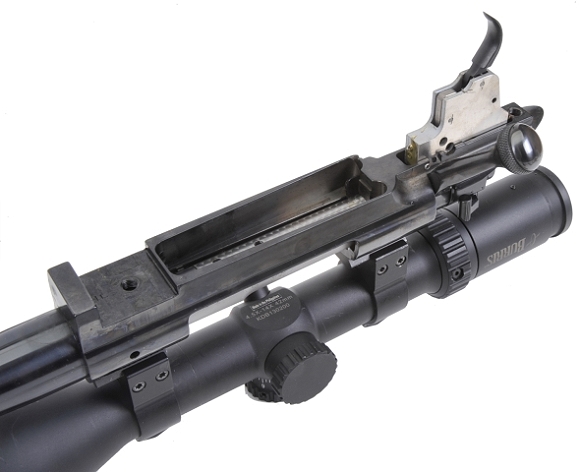
The modern Winchester Model 70 is built around an action that is forged from steel billet and then CNC machined to final form and dimensions. The receiver is flat bottomed with an integral recoil lug to properly locate the action to two glass bedded location in the rifle’s stock. The hammer forged barrel floats in the barrel channel, all contributing to the rifle’s accuracy and at 24″ the barrel is 2″ longer than most production 30-06 Springfield rifles. The trigger is the Winchester M.O.A. design, a three lever, high mechanical advantage trigger system that features: zero take up, zero creep, zero overtravel, and an adjustable pull rate of 3 to 5 pounds.
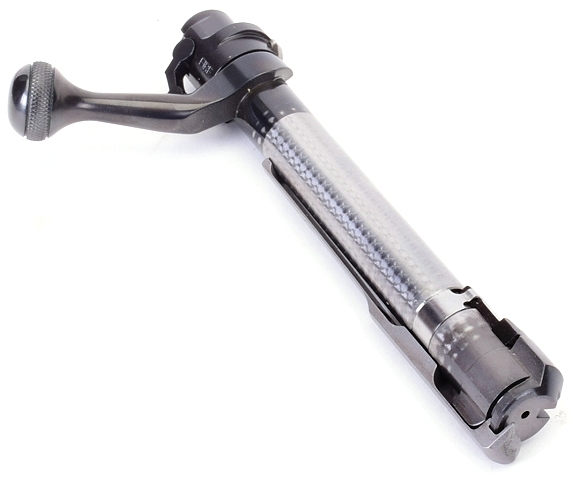
The Model 70 jeweled bolt is a controlled round feed design; a cartridge case rim slips under the large claw extractor as it is stripped from the magazine and guided into the rifle’s chamber. The same extractor covers a quarter of the cartridge’s rim as it is being withdrawn from the chamber. The ejector is a blade type, so force of ejection and distance of ejection is controlled by the shooter.
The three position safety moves horizontally on the same plane as the bore. Each position is positively located with a sprung ball detent engagement; full forward “Fire”, middle position “Safe – Bolt can be cycled”, full back “Safe – Bolt locked in battery position.
The Model 70 Super Grade has a steel hinged floorplate and bottom metal. Release is outside the guard where it is easy to reach, but not easy to hit under recoil… that special magic trick prevalent with some other brands where you take a shot, bump the release accidentally and watch all of your ammo fall to the ground before you can work the bolt and chamber a second round. I like hinged floorplates, maybe because I grew up with them. At the end of the day, should there be a rare occurrence of not getting a shot, the floorplate comes down and ammo is dumped, then the bolt is cycled once to pull the chambered round or check for empty.
Perfection is an 84 year old rifle with a 114 year old cartridge
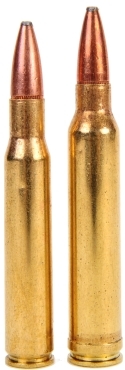 The 30-06 Springfield became a military standard cartridge in 1906 and was in wide spread service through 1970. It still sees limited use in U.S. and NATO military applications. Military returning home from war with 1917 Enfield, 1903 Springfield and M1 Garand experience remained loyal to the round when they returned to civilian life. Hundreds of thousands of military surplus firearms made their way into discount retail channels as complete firearms or barreled actions and became the subject of many amateur gunsmiths attention. Barrels were cut down, stocks were cut down, receiver ears were trimmed off, scopes were mounted and there was literally tons of military surplus ammo to power them. Of course every U.S. manufacturer and most European manufacturers offered rifles in 30-06 Springfield.
The 30-06 Springfield became a military standard cartridge in 1906 and was in wide spread service through 1970. It still sees limited use in U.S. and NATO military applications. Military returning home from war with 1917 Enfield, 1903 Springfield and M1 Garand experience remained loyal to the round when they returned to civilian life. Hundreds of thousands of military surplus firearms made their way into discount retail channels as complete firearms or barreled actions and became the subject of many amateur gunsmiths attention. Barrels were cut down, stocks were cut down, receiver ears were trimmed off, scopes were mounted and there was literally tons of military surplus ammo to power them. Of course every U.S. manufacturer and most European manufacturers offered rifles in 30-06 Springfield.
Most 30-06 Springfield rifles are used by deer hunters, but that is because with the population of hunters, more hunt deer than any other game. The 30-06 Springfield cartridge is capable of putting down any of the largest North American game and do so convincingly. The 30-06 Springfield also spawned a huge number of wildcat cartridges which led to a number of high performance factory cartridges, such as the 25-06 Remington, 270 Winchester, 280 Remington, 338-06 A-Square, and 35 Whelen.
In 1963, the 300 Winchester belted magnum (near left, next to the 30-06) was introduced. Intended to offer more power for the largest North American game, it took away some of the big and dangerous game applications, but there are still 110 factory loads for the 30-06 Springfield and 75 for the 300 Winchester Mag. If anything put a dent in 30-06 Springfield use it would be the half a century newer 308 Winchester with 141 factory loads. The Winchester Model 70 Super grade is available in all three chambers, I just had something in mind for the 30-06 Springfield project and a handload Part II is in the works.
I guess it would be good to finish Part I before launching into Part II… Est-ce vrai?
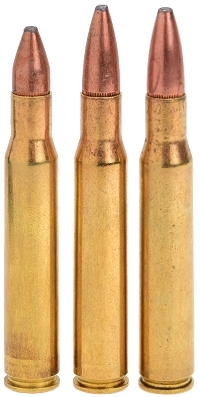 No, I don’t know what that means as I don’t speak French. Sometimes I just want to know what it feels like to be disambiguously pretentious. Three types of 30-06 Springfield ammunition were rounded up, as representative of the cartridge’s performance. A produce brand reduced to tabular table form below…
No, I don’t know what that means as I don’t speak French. Sometimes I just want to know what it feels like to be disambiguously pretentious. Three types of 30-06 Springfield ammunition were rounded up, as representative of the cartridge’s performance. A produce brand reduced to tabular table form below…
| Cartridge | Bullet Weight Grains |
Rated Velocity FPS |
Recorded Velocity FPS |
3 Shot 100 Yd Group “ |
| Rem Core-Lokt PSP | 125 | 3140 | 3100 | 0.9 |
| Rem Core-Lokt PSP | 150 | 2910 | 2942 | 0.6 |
| Rem Core-Lokt PSP | 180 | 2700 | 2795 | 0.7 |
Hornady Superformance ammunition, not included in the live fire performance summary, puts a little more heat on the cartridge with 150 grain performance at 3080 fps and 180 grain performance at 2820 fps. All of the preceding numbers are based upon a 24″ barrel length. By comparison, Hornady 300 Win Mag 180 grain Superformance has a muzzle velocity of 3130 fps which is an 11% increase over the 30-06 Springfield, but at a significant increase in ammunition cost, a significant increase in recoil and is the extra performance necessary?
With a 6″ target size and +3 maximum ordinate, even the slow poke 180 grain Remington Core-Lokt load has a 247 yard point blank range with a 232 yard best zero. At 300 yards, drop is only 5.8″, the bullet is still traveling 2135 fps and kinetic energy is 1822 ft-lbs.
Take us back to the Winchester, Chuck…
The Winchester Model 70 Super grade is what we old timers, anyone over the age of forty these days, puts into a thought bubble when someone says “hunting rifle”. A nicely figured and darkly colored black walnut stock and deep dark, almost black, metal surfaces make for a good looking rifle, without crossing the line to a fancy lad rifle. Functionally, the controls are best place for a hunting application, the trigger is slick and the bolt throw is so smooth I opened the bolt to double check that I actually stripped a round from the magazine and chambered a round; I had.
Maybe I am picky, but the last thing I want to get in the way of a hunting trip is coarse operation of a rifle. Is the faux cross bolt through the stock essential, probably not, but is done well and adds the traditional look of a Winchester express rifle. And I am certainly not going to gripe about the presence if cleanly inlet swivel studs and 20 lines per inch cut checkering. If you’ve shot a 30-06 Springfield chambered rifle, you’ll probably appreciate the Pachmayr Decelerator recoil pad and the increased heft of the Super Grade. The extras on the stock, mostly, add a pound over the plain Sporter version of the Model 70.
I’m going to break here and be back with some handloads at the heavier bullet end of the 30 caliber spectrum.
1) Thomas Henshaw (1993), “The History of Winchester Firearms 1866 – 1992” p.112

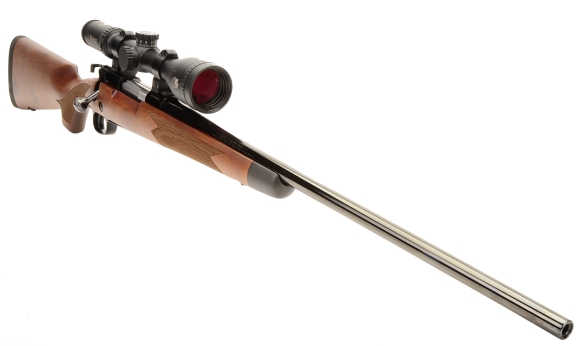

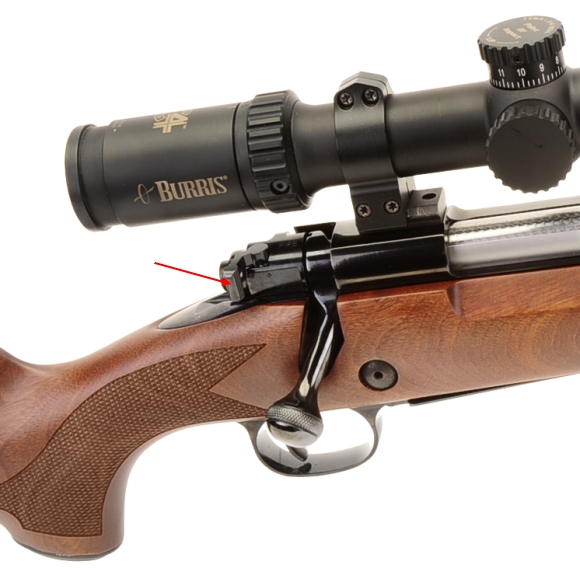
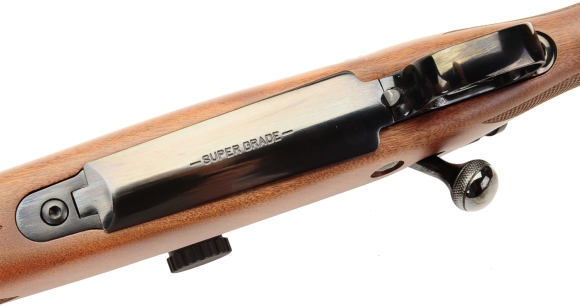

Email Notification